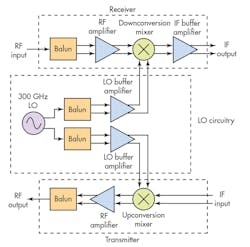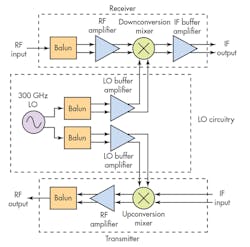300-GHz Transceiver Boasts On-Chip LO and Mixers
As an alternative to high-speed communication buses, terahertz frequencies may be an option for close point-to-point communications for Internet-of-Things (IoT) and machine-to-machine (M2M) communications—both between devices and within larger systems. When implementing terahertz technology, though, the extremely small wavelengths force researchers to develop complete integrated solutions on a single chip. To achieve a fully functioning terahertz transceiver on-chip, for example, a 250-nm indium-phosphide (InP) double-heterojunction-bipolar-transistor (DHBT) process with integrated local oscillators and mixers was used by researchers from Korea and the United States—Sooyeon Kim, Jongwon Yun, Daekeun Yoon, Moonil Kim, Jae-Sung Rieh, Miguel Urteaga, and Sanggeun Jeon.
To fabricate such a device, the researchers needed to build the local oscillators (LOs) and mixers on-chip and with the same technology. Because they operate in the fundamental mode on the same chip, the LOs and mixers reduce the chip area and direct-current (DC) consumption. They also improve the RF performance characteristics of the transceiver. For its part, the RF amplifier typology includes a five-stage differential amplifier chain with input and output matching networks. It comprises five common-base HBT pairs cascaded with 32- μm intervals.
The receiver has a noise figure of 12.0 to 16.3 dB with an intermediate frequency of 1.1 to 7.7 GHz, 3-dB bandwidth of 20 GHz, and a peak conversion gain of 26 dB at 298 GHz. With comparable performance to the receiver, the transmitter exhibits a conversion gain of 25 dB at 298 GHz, a 3-dB bandwidth of 18 GHz, and output power of -2.3 dBm. Both the transmitter and receiver operate with a combined DC power consumption of less than 1 W. See “300 GHz Integrated Heterodyne Receiver and Transmitter With On-Chip Fundamental Local Oscillator and Mixers,” IEEE Transactions on Terahertz Science and Technology, Jan. 2015, p. 92-101.
About the Author
Jean-Jacques DeLisle
Jean-Jacques graduated from the Rochester Institute of Technology, where he completed his Master of Science in Electrical Engineering. In his studies, Jean-Jacques focused on Control Systems Design, Mixed-Signal IC Design, and RF Design. His research focus was in smart-sensor platform design for RF connector applications for the telecommunications industry. During his research, Jean-Jacques developed a passion for the field of RF/microwaves and expanded his knowledge by doing R&D for the telecommunications industry.

